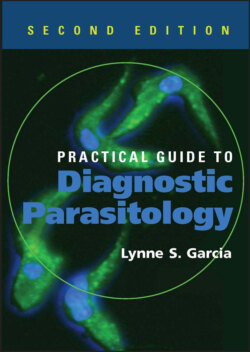Читать книгу Practical Guide to Diagnostic Parasitology - Lynne Shore Garcia - Страница 90
На сайте Литреса книга снята с продажи.
Collection of Blood Collection and Processing
ОглавлениеDepending on the parasite life cycle, a number of parasites may be recovered in a blood specimen, either whole blood, buffy coat preparations, or various types of concentrations. These parasites include Plasmodium, Babesia, and Trypanosoma spp., Leishmania donovani, and microfilariae. Although some organisms may be motile in fresh, whole blood, species are normally identified from the examination of permanent stained blood films, both thick and thin films (Table 3.4). Blood films can be prepared from fresh whole blood collected with no anticoagulants, anticoagulated blood, buffy coat cells, or sediment from the various concentration procedures (Table 3.5).
Blood can be collected from either finger stick or venipuncture. Venous blood should be collected in a tube containing EDTA. Multiple thick and thin blood films from the blood or buffy coat should be prepared and examined immediately after receipt of the blood by the laboratory, and multiple blood examinations should be performed before blood-borne parasite infection is ruled out. Unless you are positive that you will receive well-prepared thick and thin blood films from finger stick blood, request a tube of anticoagulated blood (EDTA anticoagulant [lavender top] is preferred). The tube should be filled with blood to provide the proper blood/anticoagulant ratio. For detection of stippling, the smears should be prepared within 1 h after the specimen is drawn. After that time, stippling may not be visible on stained films; however, the overall organism morphology is still acceptable. Most laboratories routinely use commercially available blood collection tubes; preparation of EDTA collection tubes in-house is neither necessary nor cost-effective. However, if the need should arise, EDTA (Sequestrene) can be prepared and tubed as follows: dissolve 5 g of EDTA in 100 ml of distilled water, aliquot 0.4 ml into tubes, and evaporate the water. This amount of anticoagulant is sufficient for 10 ml of blood. One can also use 20 mg of EDTA (dry) per tube (20 mg/10 ml of blood).
The time when the specimen was drawn should be clearly indicated on the tube of blood and also on the result report. The physician will then be able to correlate the results with any fever pattern or other symptoms that the patient may have. There should also be some comments on the test result report that is sent back to the physician that one negative specimen does not rule out the possibility of a parasitic infection.
